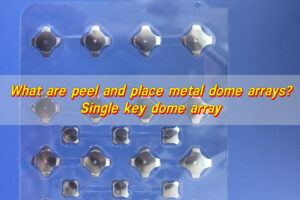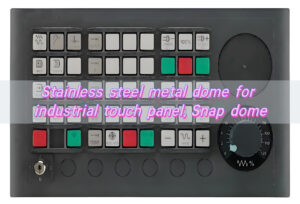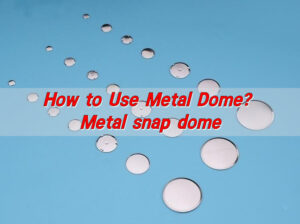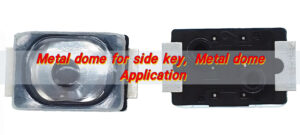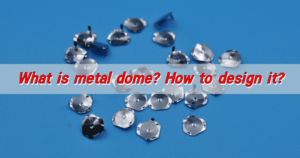Metal snap domes are elastic components used for circuit connection. They can be pressed to switch the circuit on and off. They are usually made of stainless steel or beryllium copper and have good elasticity and conductivity. When used, the snap domes are glued or welded to the substrate. When pressed, the snap domes deform and contact the circuit. When released, they return to their original shape to ensure the stability of the circuit.
How do you use a metal snap?
Using a metal snap dome is simple once you understand the structure. These tiny domes act like miniature switches. You place them between a circuit and a graphic overlay. When pressed, they collapse and complete a circuit underneath.
First, choose the right size and force. Domes come in various shapes—round, four-leg, triangle, or oblong—and in different actuation forces. A light touch might need a 180g dome. A firmer feel might need a 400g one.
Next, align the dome with precision. Using a placement jig or automated equipment helps with mass production, but hand placement works for small batches. Center the dome over the contact pad. The dome’s legs or edges must rest cleanly on the pads to ensure proper conduction.
Finally, seal it with a spacer and graphic overlay. The spacer keeps the dome in position, while the overlay protects it and displays your interface design. Press, and you’ll feel a crisp snap. That’s tactile feedback in action.
Where do you place metal snap domes?
Correct placement is critical. Even a slight misalignment can cause switch failure. Domes are usually placed directly over silver or carbon contact pads on a flexible PCB or membrane circuit.
The design must allow the dome’s center to align with the contact point. If it’s off, the tactile response will feel soft or fail entirely. Use dome retention adhesive or a dome sheet to keep them fixed in place.
For easier assembly, some manufacturers use pre-loaded dome arrays. These dome sheets hold each dome in perfect alignment, ready for mounting. This is ideal for applications where precision is key—like medical devices, military-grade electronics, or custom industrial controls.
Can metal snap domes be reused?
In most cases, yes. Metal snap domes can be reused, especially during prototyping or testing phases. If they haven’t been bent, scratched, or damaged, they still work just as well.
But in high-volume production or when absolute reliability is needed, we don’t recommend reusing them. Once installed with adhesive, removing them might deform the dome or leave residue behind. If that happens, tactile feedback may weaken.
Why use metal snap domes in switches?
Because they feel amazing. That “snap” you get when you press a button with a dome switch is no accident. It’s carefully designed to give you feedback. It tells the user, “Yes, you’ve pressed it.” That sensation builds confidence, speed, and accuracy.
Membrane switches without domes often feel flat. They don’t tell you if your input was successful. Metal snap domes add that unmistakable tactile feel. You press it, and you know it worked.
They also help improve durability. Domes can withstand over a million actuations. That makes them perfect for high-use applications—from medical devices to industrial control panels. And their simple construction means fewer parts to break.
In short, metal domes boost feedback, lifespan, and user satisfaction. That’s a big win for such a small part.
Are metal domes easy to install?
Absolutely. One of the best things about metal snap domes is how easy they are to install. With basic tools or even by hand, you can place them onto the PCB or circuit layer.
Manual installation is common in prototypes. Use tweezers and apply gentle pressure. For production, semi-automated machines place domes rapidly and with accuracy.
You can use single domes with a retaining adhesive or go for pre-loaded dome arrays. These sheets not only speed up the process, but they also protect domes from dust or misalignment.
Just make sure your working environment is clean and free of static. That keeps domes functioning smoothly without contamination.
How do metal snap domes work?
The science behind metal snap domes is elegant. Each dome is a curved piece of stainless steel. When pressure is applied, it collapses and touches the lower circuit, closing the loop and sending the signal.
As the dome collapses, it provides a tactile “snap” that you can feel through your finger. Once the pressure is released, the dome returns to its original shape. The circuit opens again.
This spring-like action is what makes metal domes so responsive. And because it happens so fast, the signal is almost instant. That’s what makes them perfect for applications that demand real-time input—like point-of-sale machines, remote controls, or diagnostic instruments.
What mistakes to avoid with snap domes?
Even though domes are simple, a few mistakes can ruin performance. The most common is misalignment.
Another mistake is using damaged domes. Bending them out of shape or applying too much pressure during installation can reduce their lifespan.
Avoid using excessive adhesive. While dome retention is important, too much glue can interfere with actuation.
And finally, make sure your circuit layout is clean and consistent. Poor pad design or uneven surfaces can prevent full dome contact. That leads to weak signals and failed inputs.
Do metal snap domes improve feedback?
Without a doubt, yes. Metal snap domes are built to provide clear, positive feedback. That crisp snap you feel isn’t just satisfying—it helps users trust their input.
When you’re working fast or under pressure, you don’t want to second-guess whether a button was pressed. That tactile response removes hesitation. It enhances speed and reduces errors.
For consumer electronics, that means a better user experience. For industrial tools, it means fewer mistakes. For medical devices, it means peace of mind. Feedback is everything—and domes deliver it.
They also offer audible confirmation. That tiny click sound is reassuring. Users hear it, feel it, and know the system registered the command.
Conclusion:
Whether you’re building a custom interface, testing a new control system, or scaling up production—metal domes make it easier, faster, and more reliable. With the right technique, installation is quick. The feedback is sharp. And the result is always satisfying.
If you’re still unsure which dome is right for your project or need expert help with design and application, our team is here to help. Reach out today. Contact us at sales@metal-domes.com







